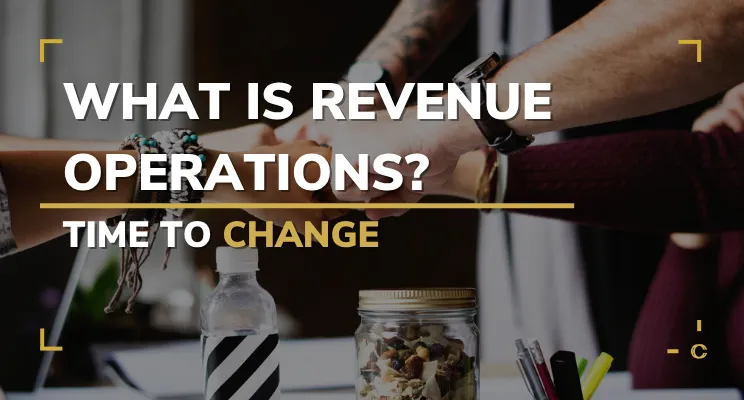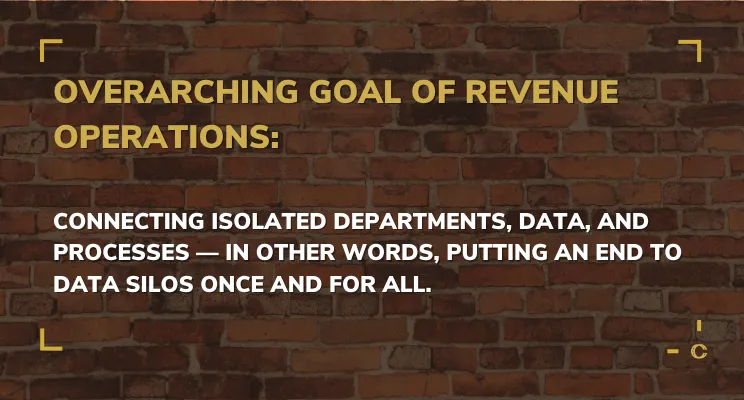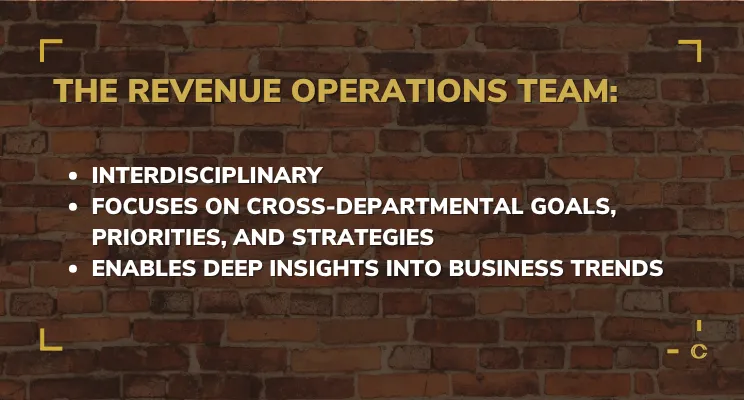.webp)

.gif)

You’re hearing “Revenue Operations” more and more. Titles like “Director of Revenue Operations” or “VP Revenue Operations” are showing up on LinkedIn. New roles are being hired. Modern companies are restructuring around it. But what does it actually mean? Why is this not just another short-lived buzzword? And how can Revenue Operations create real value for your business? Let’s get into it.

Before we talk about the value of Revenue Operations for your company, let’s define what we’re actually talking about.
At a high level, RevOps exists to connect what used to be isolated teams, data, and processes and connect them in a way that benefits the entire business, not just one function.
You can think of it like this: RevOps sits in the gaps between previously disconnected areas and turns them into one connected system across the whole company. In this cross-functional role, Revenue Operations teams work along the entire customer journey on processes, enablement, data analysis, and internal training. What used to “cook in separate pots” now goes onto one shared table.
The simple equation looks like this:
Revenue Operations = Marketing Operations + Sales Operations + Closing & Post-Sales Operations (Customer Success)
By acting as the connective tissue, companies are finally able (either for the first time, or in a way more structured / scalable way than before) to align company-wide goals, priorities, and strategies with people, processes, and systems across departments.

In an ideal setup, the Revenue Operations team is a neutral partner that works closely with each department to drive key business initiatives and make planned outcomes actually happen. RevOps owns and runs projects end-to-end, including analysis (data gathering), modeling, tooling decisions, project management, and reporting.
On top of that, RevOps creates visibility into how the business is trending. That’s what makes truly data-driven decisions possible in the first place, because: Revenue Operations has an unmatched, end-to-end view of company performance.
Sales Operations is fully focused on sales: the sales org, its processes, reporting, analytics, enablement, training. You can think of Sales Ops as a sub-discipline within Revenue Operations.
Revenue Operations, on the other hand, works “behind the scenes” to collect and connect data, and keeps the conversation flowing between Sales and the rest of the company. While the sales team is out selling, RevOps is integrating data and processes from Marketing and Customer Success with sales data and sales processes.
That integration is what allows RevOps to actually support the whole go-to-market engine instead of just one function.

Is all this effort actually worth it? Short answer: absolutely yes.
When you evolve from just Sales Operations to true Revenue Operations, you unlock a set of advantages that are very hard to build any other way:
You get reporting, metrics, and analysis across the entire pipeline — not just “marketing numbers” or “sales numbers” or “CS numbers,” but one view.
“RevOps is the operating system of your go-to-market. Connect data, decisions, and delivery, and growth stops being ‘best effort’ and starts being predictable.”
— Michael J. Jäger
Sounds great. You want this. So how do you actually start without blowing everything up?
The core success factor is this: connect your data and your processes.
Step one (highest priority): close the gap between Marketing and Sales.

In practice, that can look like assigning someone from Sales Operations to take ownership of Marketing Operations topics as well. That person becomes the bridge and forces alignment between both teams.
From a systems point of view, that often means connecting tooling, e.g. Pardot + Salesforce, or HubSpot Marketing Hub + Sales Hub. Now both teams work from one shared source of truth instead of two separate realities.
Also important early on: set up short, tight feedback loops between Sales and Marketing. Not once a quarter. Ongoing. You want a constant exchange, not a post-mortem.
Step two: once Marketing and Sales are aligned, bring Sales and Customer Success to the same table.
The first priority here is clean handover. Accounts need to move between teams without data loss, without missing context, without guessing what was promised.
After those system integrations are in place, RevOps should drive an ongoing dialogue between these teams, through process optimization, internal enablement, and reporting. That’s how you create cross-functional growth instead of local optimisation.
You want to go deeper on this or figure out how this would look in your org? Grab 20 minutes on my calendar and let’s talk.
Read on: Are you wondering when the best time is to get started with RevOps? Check out our article.
Presenting our distinguished clientele! We collaborate closely with visionary B2B tech and software companies, intricately shaping their comprehensive Revenue Architecture. Take a look at who we have already served.

Explore our captivating customer success
stories here.


























































































You have questions? Our Founder and Managing
Partner Michael is looking forward to hearing from
you.